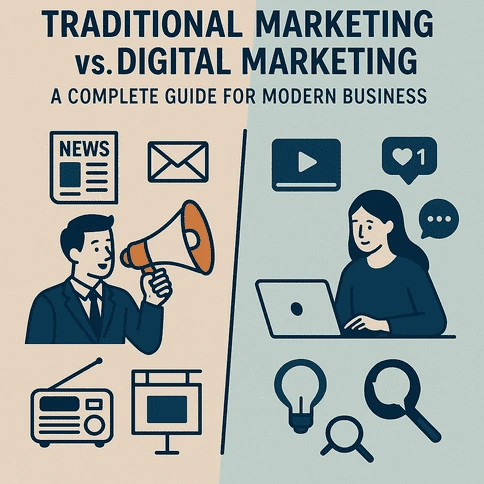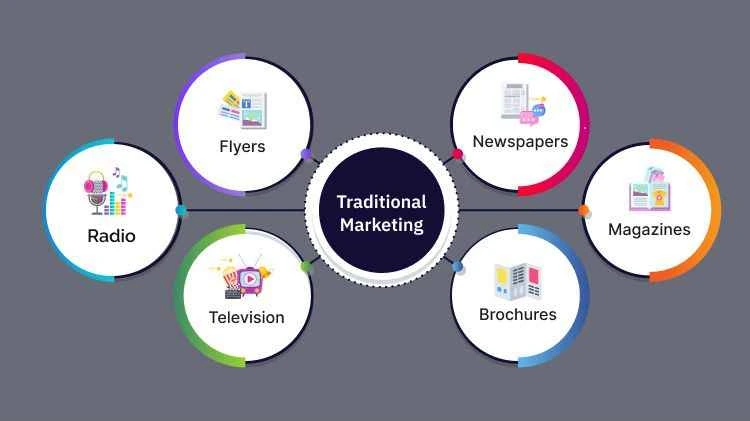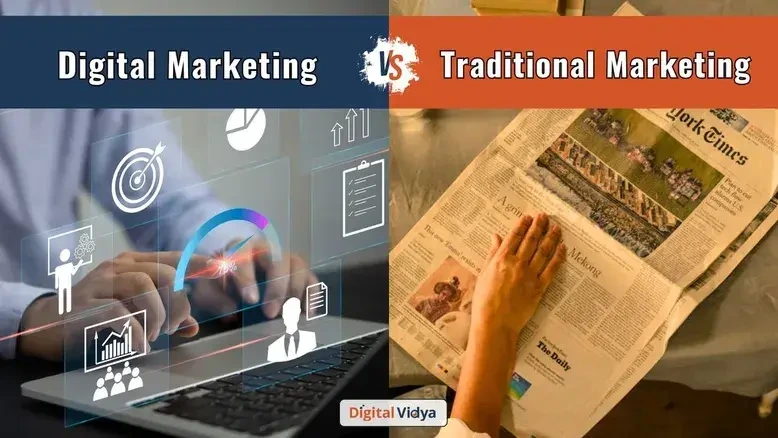
Introduction
Traditional Marketing vs Digital Marketing : – marketing strategies have significantly expanded as a result of the quickly changing business and advertising landscape.in the ever changing business and advertising world which has seen great transformation in very little time, out traditional marketing which has been the base of advertising for what seems like forever is what we see today’s digital marketing to have taken over. What we must see to make sense of this is to study both of these marketing types out in full their relevance, strengths, weaknesses and what they hold for the future. This is key for companies which want to do well in today’s very competitive environment.
What is traditional marketing

In the past we saw businesses use what we today term as traditional marketing to reach out to consumers which pre- dated the digital age. This included TV and radio ads, print media newspapers, magazines), billboards, brochures, and direct mail. It was a mostly one way communication from the company to a large audience which they in turn we hoped would notice our message and take action. While it may come off as old school in this digital age traditional marketing still does very well, in fact for local businesses and industries that value personal touch and wide scale visibility it is still a very effective strategy.
What is digital marketing

Digital marketing is that which is done via electronic devices and the internet. Traditional marketing vs digital marketing Companies use digital channels like search engines, social media, email, websites, mobile apps, and content marketing to reach present and future customers. What digital marketing does is it is interactive and in real time which traditional marketing doesn’t do also it has a two way communication between the brand and the consumer. Also it allows companies to target very specific demographics and to personalise content based on user behavior which in turn improves the results of the campaign.
The Future of Traditional Marketing
Digital platforms now lead the marketing conversation, yet traditional methods refuse to fade away. Looking ahead, print ads and handouts will work side by side with fresh tech, creating a seamless consumer journey. Think QR codes that pull up coupons, or magazine pages you scan to see a pop-up video-a small bridge between the paper and the screen. Dominance may tip toward pixels, but old-school tactics will still boost local visibility at fairs, clinics, schools, and real-estate open houses, where familiarity and trust matter most.
The Future of Digital Marketing
In the years to come, digital marketing is expected to grow at an exponential rate. Big data, AI, and machine learning are becoming more and more popular very quickly. This will make digital marketing even more automated and tailored to each person. Some of the things that will happen in the future are virtual and augmented reality experiences that are very immersive, influencer marketing, chatbots with AI-powered customer service, voice search optimization, and ads that are very specific to a person’s behavior in real time. Digital marketing is likely to take over the business world as user data becomes more important for creating customer journeys.
Importance of Traditional Marketing
- Credibility: Traditionally, older demographics tend to find traditional channels to be more trustful.
- Brand establishment: Big brands are using traditional media to keep brand message in front of people consistently.
- Tangible Medium: Things like brochures, flyers, and banners are more permanent in nature than digital advertising advertisements are.
- Local targeting: Is great for targeting local communities and demographic groups that may not be engaged with digital media as much.
Importance of Digital Marketing
- Global reach: Companies can reach a global audience immediately and cost -effectively.
- Real -time analysis: Markets can trace the success of real -time campaigns and can make adjustments quickly.
- Cost efficiency: Digital expeditions are often more cheap than traditional methods, especially for small businesses.
- Targeted advertising: Capital can now reach specific target groups based on interests, behavior, location and demographics.
Merits and Demerits of Traditional Marketing
Benefits and drawbacks of conventional marketing Billboards and journals advertise you cannot miss. Credibility: Radio or television commercials often make people trust companies more. Excellent for reaching many people where the internet is not widespread. Cons: Print, radio, and television advertisements are pricey. Difficult to follow: Knowing how well a campaign did is challenging. Fixed Material: You can’t alter something once you print or broadcast it. You don’t get to face-to-face communicate with your audience
Merits and Demerits of Digital Marketing
Benefits :Cost-Effective: Perfect for companies with modest marketing expenditures. Reach particular populations or interest groups using highly targeted approaches. Flexible: On-the-fly changes or updating of marketing plans is simple. Demerits :Users might be hesitant about data monitoring and advertisements, hence raising privacy issues. User behavior includes ad blockers and ignoring of digital commercials. Over-Saturation: The internet is congested, making it difficult to distinguish oneself. Digital developments and platforms change quickly.
Traditional vs Digital: Which is Better?

Old-school TV spots, billboards glaring at you from the freeway, radio jingles you can’t get out of your head. Still works, especially if you’re a big shark with deep pockets and want the whole country buzzing.
But then you’ve got digital—Facebook ads, influencer collabs, all that jazz. Perfect for the scrappy upstarts who actually wanna see who’s clicking their stuff. Way more targeted, probably cheaper too, unless you’re burning cash on TikTok for no reason.
Honestly, most smart brands aren’t picking sides. They’re mixing it up. You might catch a slick TV commercial during your favorite show, and then—bam!—that same brand slides into your Instagram feed with a discount. It’s all about hitting people wherever they hang out. If you’re only doing one, you’re probably leaving money on the table.
How to Choose the Right Marketing Strategy
Picking out a marketing strategy isn’t just ticking boxes on some corporate checklist. You gotta ask yourself:
Who the heck are you even trying to reach? Are they scrolling Instagram at midnight or lurking on LinkedIn during their lunch break?
What’s your wallet situation? If you’re broke, don’t go blowing your rent money on fancy ads.
What’s the endgame here? Do you wanna be the next household name, snag a bunch of hot leads, or just straight-up sell stuff and watch the cash roll in?
Also, what’s the competition up to? Don’t sleep on those guys—they might have a few tricks worth stealing (I mean, “adapting”).
And, where are you aiming? Are you just trying to rule your neighborhood, or do you have world domination in mind? Global? Regional? Just your block?
Yeah, it’s a lot. But hey, nobody said marketing was simple.
🛠️ Stuff We Actually Use
- Old-School Marketing Junk:
- Billboard dudes (you know the ones, staring at traffic all day)
- Print shops—smells like ink and regret
- Those TV and radio folks who still cold-call like it’s 1998
- Digital Wizardry:
- Google Analytics—where spreadsheets go to party
- Meta Ads Manager (aka Facebook’s confusing control room)
- Canva and Adobe Creative Suite—pixel pushing central
- HubSpot, Mailchimp, SEMrush—email blasts, spammy magic, and SEO rabbit holes
🔍 Detailed Comparison on Different Aspects
Traditional Marketing vs Digital Marketing
1. Consumer Trust and Brand Perception
Let’s be real—those cringey old TV jingles? They stick in your head like gum on a sneaker. And those glossy ads with people cheesing so hard you wonder if their faces hurt? Classic. It’s got that “comfort food” vibe, like the ratty sweatshirt you know you’ll never toss. But who’s actually watching cable now?
Seriously, most of us are doom scrolling or getting sucked into TikTok rabbit holes. Brands don’t live in glossy magazines anymore, they live in memes, roasts, and whatever wild trend Twitter’s losing its mind over next. And reviews? Oh man, reviews are basically sacred scripture now. Somebody’s roommate swears by a product in the group chat, and suddenly, everybody’s adding to cart. So yeah—nostalgia’s cool and all, but if you want people to really trust your brand? Better show up where the chaos is. That’s just how it goes now.
2. Adaptability and Speed
Digital campaigns move at the speed of gossip. Didn’t get enough clicks? Pull it. Tweak it. No sweat. On the flip side, print or TV is like carving your message in stone. Messed up the ad? Welp, hope you like spending more cash to fix it. There’s no “undo” button in your local newspaper.
3. Lead Generation Quality
Tracking digital leads? It’s a breeze. You see who clicked, who bought, and who just stalked your site at 2am. CRMs do the heavy lifting, slicing and dicing your data. Traditional leads? They’re kind of a mystery. Some guy at a trade show took your pen—does he even remember your company’s name? Good luck finding out.
4. Mobile Marketing Integration
Digital is glued to your phone, no question. Texts, app notifications, creepy-accurate location ads—marketers are basically in your pocket. Traditional marketing can’t touch this. Like, a billboard’s not gonna ping your phone when you walk by. (Yet. Please don’t give them ideas.)
So yeah, both sides have their moments, but digital’s faster, sneakier, and just… everywhere. Old-school’s got charm, but the future’s definitely swiping right on digital.
Conclusion: The Balanced Marketing Approach
So, here’s the deal—old-school marketing and digital marketing? Each one’s got its own superpowers. Traditional marketing? That’s your handshake, your billboard, your “I’ve seen that logo since I was a kid” vibe. People trust it. It’s got roots. But digital? Man, it moves fast, doesn’t drain your wallet as much, and lets you laser-focus on exactly who you wanna talk to. Honestly, if you’re not mixing the two, you’re probably leaving money on the table.
Doesn’t matter if you’re slinging cupcakes on Main Street or building the next tech empire—if you don’t get how both of these marketing beasts work (and when to use which), you’re flying blind. Mash ‘em together, play to their strengths, and you’re way more likely to build a brand that actually lasts. Simple as that.
- For know more services elwinjose.com